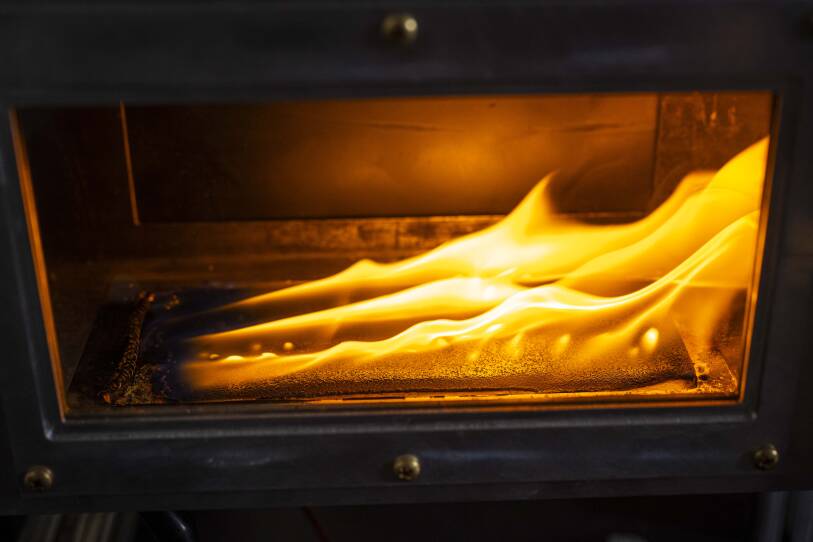Since 2000, wildfires have destroyed an average of seven million acres each year. And with rising global temperatures from climate change, the threat is growing exponentially.
Researchers at labs and educational institutions are working hard to better understand wildfire behavior, but there’s another place where wildfire research is being conducted: it’s in orbit.
In early August, Worcester Polytechnic Institute’s fire protection engineering professor, James Urban, oversaw the transfer of sample materials to NASA for transport to the International Space Station. Astronauts on the ISS will conduct experiments, and Urban hopes that, with the results, he’ll be able to grow our collective understanding about how fires spread.
Urban joined GBH’s All Things Considered host Arun Rath to share more about the project. What follows is a lightly edited transcript.
Arun Rath: I understand there’s a lot of materials research that happens in zero gravity, but this seems a little bit unusual since wildfires burn “at 1g” [here on Earth]. What can research in space tell us about fires that take place on Earth?
James Urban: Well, microgravity is a strange environment where we can gain a lot more control over the flow in ways that we simply can’t do on Earth, chiefly because of the effects of gravity. Specifically, in this case, by removing gravity from the equation, so to speak, we’re able to better control the flow that a flame experiences by changing the airflow in a way [that is] mimicking some of the behavior we might see on Earth — but in a totally different way.
Rath: So it’s an environment where you have almost total control of the parameters of the fire?
Urban: I wouldn’t say total control, but in this case, a way of control that we can’t do on Earth.
Rath: Control of gravity is pretty big.
Urban: We’re not actually controlling the gravity; we’re just sort of replacing it, if that makes sense.
Rath: So, what happens with these experiments? Are they basically burning these materials in zero gravity? How does it work?
Urban: Well, they’ve got a whole very complicated set up there, where they can do many different types of experiments. These experiments are one of several that are ongoing on the space station. They have a sealed chamber where they can load the samples in and control the environment, as well as the airflow that the samples will experience as they burn.
We can control those from the ground and try out different flow conditions, and examine the results and make measurements from the Earth.
Rath: And the measurements — what sort of things are you measuring? What kind of sensors or cameras are trained on this?
Urban: We can actually get by with measurements made by just a normal, color digital camera. But from there, you can get a lot of information about the luminosity of the flame, the movement of the flame and things like that. We actually rely very heavily on the still photos and videos that we get.
Rath: To the trained eye, there’s a lot you can tell from looking at the flame.
Urban: We use — not just by eye — but we use image-processing methods to track the motion of the flame. One of the main measurements that we’ll be looking at in this project is the rate at which the flame moves over the sample. From that, we can get camera footage from this experiment.
“That’s part of the excitement: we don’t truly know what we’re going to get until we get the data back.”James Urban at Worcester Polytechnic Institute
Rath: What kind of materials are you testing?
Urban: So, oddly enough, the main goal here is to sort of understand phenomena we see in wildfires, but we’ll actually be burning plastic — a specific plastic called PMMA, which is a very well-characterized and well-studied fuel in fire research. It makes it a great fuel to use for scientific research such as this.
Rath: Interesting. What kind of data are you expecting?
Urban: We’re expecting to see non-steady flame behavior as the flame responds to changes in the airflow. This is like the non-steady flame behavior that we might see in certain types of wildfires here on Earth.
Rath: What does that actually look like? What are fires like in zero gravity or microgravity?
Urban: Well, it depends a lot on the flow. If you think about a normal candle flame here on Earth, it has sort of a teardrop shape. That’s because the hot gases are rising, and that sort of induces that shape that you see.
In microgravity, there’s no airflow. If you were to burn a candle, you would see a spherical flame that would be very blue. But if you start to apply airflow to it, you might see something more similar to what you see with the candle flame, but a little bit different.
So, we’re going to see something like that — it’s going to be a yellower flame because we have the airflow, but it’s definitely going to look different than [the flame] we would see here on Earth.

Rath: What are the kinds of things about wildfire behavior on Earth that could be clarified, potentially, by these experiments?
Urban: Well, I guess I wouldn’t say clarified, but I would say we’re able to study this at a much more fundamental, smaller level, where we get a lot more control.
In certain types of wildfires that spread across the ground, there’s this non-steady flame behavior that happens that’s very important for how they spread. But to try to measure this, it’s very difficult, because trying to put a bunch of expensive diagnostics near a very large fire is kind of dangerous and expensive.
Also, if you try to shrink it down, those non-steady flame behaviors and wildfires depend on the size of the fire and gravity, so it’s hard to shrink them down on Earth. But in the space station, we’re hoping to create very similar non-steady fire behaviors with the wind so that we can study how the sample responds to the non-steady flame behavior.
Rath: It sounds like this could broaden not just knowledge of wildfires, but just how fires burn. Is that right?
Urban: Oh, sure. I think there’s definitely other places where this could have an impact. I mean, any case where you see you have a flame that’s spreading in a non-steady way — it just so happens that wildfires were the thing motivating me when I was writing the proposal for this project.
Rath: Talk about some of the other areas this could affect.
Urban: Well, there are a lot of other examples of non-steady fire behavior. One example is upward flame spread, which you might see in a facade fire. In that case, it wouldn’t be these fluctuations that a lot of the experiments and the study will be investigating. But you might see an accelerating fire front.
We’ll actually have a couple of tests that will be doing accelerating airflows to sort of mimic this in a way — not totally intentionally, but it just so happens it’s a good baseline experiment to do as well.
Rath: It must be exciting as a research that — I mean, I don’t know if it’s the right word to use — but getting this kind of just pure, raw data about something that we have not been able to study in this regard before.
Urban: Oh, definitely. I think it’s very exciting up in orbit doing experiments in microgravity. There’s so much that hasn’t been done before, and I know that other research in microgravity continues to provide surprising results.
I think that’s part of the excitement: we don’t truly know what we’re going to get until we get the data back.









